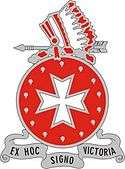14th Field Artillery Regiment
| 14th Field Artillery Regiment | |
|---|---|
|
Coat of arms | |
| Active | 1916 |
| Country |
|
| Branch | Army |
| Type | Field artillery |
| Motto(s) | Ex Hoc Signo Victoria (Victory By This Sign) |
| Insignia | |
| Distinctive unit insignia |
 |
| U.S. Field Artillery Regiments | |
|---|---|
| Previous | Next |
| 13th Field Artillery | 15th Field Artillery |
The 14th Field Artillery Regiment is a field artillery regiment of the United States Army first constituted 1 July 1916 in the Regular Army at Fort Sill, Oklahoma.
Lineage
Constituted 1 July 1916 in the Regular Army as the 14th Field Artillery
Organized 1 June 1917 at Fort Sill, Oklahoma
Inactivated 1 September 1921 at Fort Sill, Oklahoma
Assigned 15 December 1922 to the 6th Division (1st Battalion concurrently activated at Fort Sheridan, Illinois)
Relieved 7 September 1927 from assignment to the 6th Division and assigned to the 7th Division (1st Battalion concurrently consolidated with the 2d Battalion, 3d Field Artillery, and consolidated unit designated as the 2d Battalion, 3d Field Artillery - hereafter separate lineage; new 1st Battalion concurrently constituted)
(1st Battalion activated 1 December 1934 at Fort Riley, Kansas; inactivated 1 July 1936 at Fort Riley, Kansas)
Relieved 16 October 1939 from assignment to the 7th Division
Assigned 15 July 1940 to the 2nd Armored Division and activated at Fort Benning, Georgia
Reorganized and redesignated 8 January 1942 as the 14th Armored Field Artillery Battalion
Relieved 1 April 1957 from assignment to the 2d Armored Division; concurrently reorganized and redesignated as the 14th Artillery, a parent regiment under the Combat Arms Regimental System
Redesignated 1 September 1971 as the 14th Field Artillery
Withdrawn 16 May 1988 from the Combat Arms
Distinctive unit insignia
- Description
A silver color metal and enamel device consisting of a red disc charged with a white Maltese cross within a ring of fourteen gouttes d’eau (silver) reversed; attached above is a wreath of the colors, silver and red, on which is a red and white American Indian war bonnet surmounting a silver arrow. Attached below, a silver triparted scroll inscribed "EX HOC SIGNO VICTORIA" in black letters. The overall dimension is 1 1/8 inches (2.86 cm) in height.
- Symbolism
Scarlet (red) is a color traditionally associated with Artillery units. The cross, a heraldic device, and utilized by the Indians in Oklahoma, is symbolic of the morning star and is representative of the dawn of the 14th Field Artillery. The fourteen drops of water correspond to the numerical designation of the regiment. The irregular placement of the drops is to represent a dried peyote, a species of small cactus, one of the sacred emblems of the Comanche and Kiowa Indians. The war bonnet pierced by the arrow of Satanta, a noted Kiowa chief of the mid-19th century, is really a spear with a feathered end and leather grip. Satanta was well known among all the Indians of the Fort Sill region.
- Background
The distinctive unit insignia was originally approved for the 14th Field Artillery Regiment on 20 October 1923. It was redesignated for the 14th Field Artillery (Armored) Regiment on 25 October 1940. The insignia was redesignated for the 14th Armored Field Artillery Battalion on 30 March 1942. It was redesignated for the 14th Artillery Regiment on 21 November 1958. Effective 1 September 1971, it was redesignated for the 14th Field Artillery Regiment. The insignia was amended to correct the description and revise the symbolism on 7 November 1991.
Coat of arms
- Blazon
- Shield
Gules a broad armed Maltese cross with slightly reentrant ends Argent within fourteen gouttes d’eau reversed arranged in the outline of peyote (one of the cactus family, in outline approximating a circle).
- Crest
On a wreath of the colors, Argent and Gules, an American Indian war bonnet Gules and Argent over Satanta’s arrow of the last.
- Symbolism
- Shield
Scarlet (red) is a color traditionally associated with Artillery units. The cross, a heraldic device, and utilized by the Indians in Oklahoma, is symbolic of the morning star and is representative of the dawn of the 14th Field Artillery. The fourteen drops of water correspond to the numerical designation of the regiment. The irregular placement of the drops is to represent a dried peyote, a species of small cactus, one of the sacred emblems of the Comanche and Kiowa Indians. Crest The war bonnet pierced by the arrow of Satanta, a noted Kiowa chief of the mid-19th century, is really a spear with a feathered end and leather grip. Satanta was well known among all the Indians of the Fort Sill region.
Current configuration
- 1st Battalion - currently with 75th Field Artillery Brigade.
Campaign participation credit

World War II: Sicily (with arrowhead); Normandy; Northern France; Rhineland; Ardennes-Alsace; Central Europe
Vietnam: Defense; Counteroffensive; Counteroffensive, Phase II; Counteroffensive, Phase III; Tet Counteroffensive; Counteroffensive, Phase IV; Counteroffensive, Phase V; Counteroffensive, Phase VI; Tet 69/Counteroffensive; Summer-Fall 1969; Winter-Spring 1970; Sanctuary Counteroffensive; Counteroffensive, Phase VII; Consolidation I
Decorations
Presidential Unit Citation (Army) for NORMANDY
Presidential Unit Citation (Army) for PLEIKU PROVINCE
Meritorious Unit Commendation (Army) for VIETNAM 1965-1967
Meritorious Unit Citation (Army) for UNITED ARAB EMIRATES 2013-2014
Belgian Fourragere 1940
Cited in the Order of the Day of the Belgian Army for action in the ARDENNES
Cited in the Order of the Day of the Belgian Army for action in BELGIUM
See also
- Coats of arms of U.S. Artillery Regiments
References
![]() This article incorporates public domain material from the United States Army Institute of Heraldry document "14th Field Artillery Regiment".
This article incorporates public domain material from the United States Army Institute of Heraldry document "14th Field Artillery Regiment".
External links
- http://www.history.army.mil/html/forcestruc/lineages/branches/fa/default.htm
- http://www.14faregiment.org/
